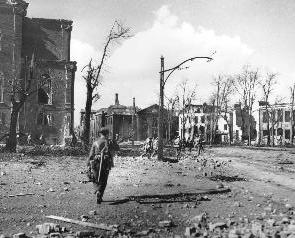Table of Contents | Rhineland | Netherlands | Germany | Synopsis | Reviews | To Order | Order of Battle
Award Statistics | British Gallantry Awards | Photo Gallery
Framework of the 1945 Campaign
The 3rd Canadian Infantry Division in the Liberation of the Netherlands
The final assault on Germany began on the night of 23/24 March, when the XXX British Corps made an assault crossing of the Rhine. The 9th Canadian Infantry Brigade of the 3rd Division became the first Canadian formation to cross the Rhine, as it moved up early on March 24 to support the 51st Highland Division in the Rhine bridgehead. In this role, it bore the brunt of a German counter attack by units of the German 15th Panzer Grenadier Division. Heavy fighting took place for the villages of Speldrop and Bienen. In Bienen, the Germans were determined not to yield. German self-guns propelled guns entered the village at dusk and an armoured battle erupted between them and the suppporting Sherman tanks of the 2nd Armoured Brigade.
 The fighting, however, exhausted the last of the German reserves and on March 28, the 3rd Division broke out to attack Emmerich, a city which normally had a population of 16,000. It had been heavily bombed and was completed devastated. The fresh German division, supported by self-propelled guns, sent to defend this city made use of the piles of rubble, turning the cellars into strong-points . It took two days to secure the city, in house-to-house fighting described as being similar to "guerilla warfare" in which snipers and anti-personnel mines were particularly difficult.
The fighting, however, exhausted the last of the German reserves and on March 28, the 3rd Division broke out to attack Emmerich, a city which normally had a population of 16,000. It had been heavily bombed and was completed devastated. The fresh German division, supported by self-propelled guns, sent to defend this city made use of the piles of rubble, turning the cellars into strong-points . It took two days to secure the city, in house-to-house fighting described as being similar to "guerilla warfare" in which snipers and anti-personnel mines were particularly difficult.
(Photo Credit: National Archives of Canada, PA-137323)

|
(Photo Credit: National Archives of Canada, PA-112640)
|
On 29 March, Field Marshal Montgomery declared the Battle of the Rhine had been won and issued orders for the next phase. While the Second British Army advanced on Berlin, the First Canadian Army was given the task of liberating the Netherlands. The 3rd Canadian Infantry Division would advance north and follow the east bank of the Ijssel River to cut off the western Holland. The German forces gathered all the strength they could to hold the Canadians in the towns of Zutphen, Deventer and Zwolle, as well as along the Schipbeek and Overijssels Canals, but by 18 April, the Division had sealed the causeway across the Zuider Zee (Ijsselmeer), accomplishing its mission.
During this period, men of the 3rd Division were awarded 73 gallantry decorations for courage in battle.
The Rhineland|Table of Contents | Germany
 The fighting, however, exhausted the last of the German reserves and on March 28, the 3rd Division broke out to attack Emmerich, a city which normally had a population of 16,000. It had been heavily bombed and was completed devastated. The fresh German division, supported by self-propelled guns, sent to defend this city made use of the piles of rubble, turning the cellars into strong-points . It took two days to secure the city, in house-to-house fighting described as being similar to "guerilla warfare" in which snipers and anti-personnel mines were particularly difficult.
The fighting, however, exhausted the last of the German reserves and on March 28, the 3rd Division broke out to attack Emmerich, a city which normally had a population of 16,000. It had been heavily bombed and was completed devastated. The fresh German division, supported by self-propelled guns, sent to defend this city made use of the piles of rubble, turning the cellars into strong-points . It took two days to secure the city, in house-to-house fighting described as being similar to "guerilla warfare" in which snipers and anti-personnel mines were particularly difficult.